
Mission Statement:
"To advance through research, education and symposia, an increased public awareness of the Cape Fear region's unique history."

Duplin Roads Before Wallace: A History
Cape Fear Historical Institute Papers
www.cfhi.net
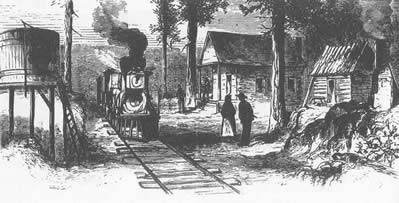
Early Years of Duplin Cross Roads, or Duplin Roads:
The present town of Wallace, first known as Duplin Roads,
was first incorporated as Duplin Roads in 1873; then
reincorporated as Wallace in honor of Stephen D. Wallace
(see Notes below) of the Atlantic Coast Line railroad on
March 4, 1899. The county of Duplin had originally been
part of New Hanover but a split was made in 1749 in order
to better administer government to the inhabitants.
Those first settlements of Swiss, German and Scotch-Irish
in Duplin County occurred between present-day Wallace
and Teacheys in the vicinity of the Old Red House Cemetery.
At the end of the American Revolution the area that now comprises
the town of Wallace was farmland owned by William Boney, much
of it from an earlier land grant of King George II. The name Duplin
Roads emerged from the intersection of the Wilmington to Raleigh
dirt road and the New Bern to Fayetteville road, and the coming
of the railroad in 1840 spurred development of the crossroads
into a market and transportation center.
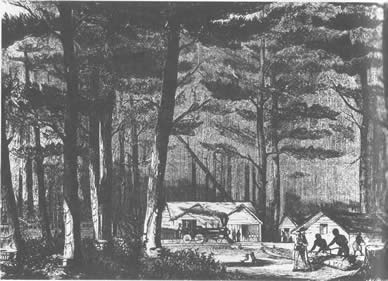
Readying Turpentine for Shipment by Rail
The new railroad brought new importance to
the Duplin Roads community as the spacing of stations along the
rail line reflected the practical need for locomotives to take on
necessary water and wood. It is also important to note that the
Wilmington and Weldon truly connected Duplin Roads to the
greater outside world and markets, as it not only connected local
farmers to Virginia, but also Charleston via the four railroad-
owned steamers that carried people and freight from Wilmington
southward on a water route.
No Whiskey at Duplin Roads Station:
The land for the railroad’s right of way was a donation from
William Boney with the specific restriction that no alcohol be sold on
this land---“Thus it was that although whiskey was sold in practically
every station from Wilmington to Weldon, none was ever available
for sale in Duplin Roads station.” The new railroad crossing in
Duplin Roads prompted merchant Gabriel Boney to relocate his commissary from nearby Washington Creek on the Northeast Cape
Fear River, no doubt the first retail store in town, and his shelves
held coffee, sugar, salt and other necessities
not produced on local farms.

Steamboat Transportation on the Cape Fear River
The movement of this merchant to Duplin Roads illustrates the
effect of the new mode of transportation in the area as farm products
were now able to be shipped in large quantities to distant locales,
and at an average speed of 22 miles per hour. Crude turpentine had
for many years served as the primary cash crop in Duplin, shipped
on rafts to Wilmington for distillation into spirits of turpentine and
rosin. Near the railroad in Duplin Roads, Newkirk Southerland
had constructed barrels in his copper shop for this still-profitable
business and by 1861 the town had grown into a thriving community.
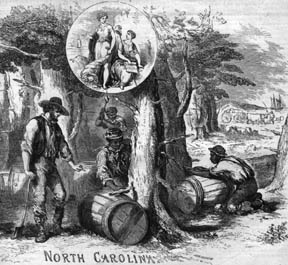
Tapping Pine Trees for Turpentine
It is notable that Thomas O. Larkin, a native of Charlestown, Massachusetts, opened a store at "Rockfish" August 18, 1825,
at or near Duplin Roads. In late 1825 he had ben appointed justice
of the peace in Duplin County, and by September, 1826 Larkin
had a post office in his store, being commissioned postmaster
at the young age of 24.
Larkin left Rockfish in 1831 for California and opened a store
at Monterey, still considered Mexican territory at the time.
He was successful in business there and in 1843 received
appointment as United States Consul at Monterey, eventually
assisting in securing California as a US possession.
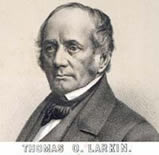
Country Town of Duplin Roads
At a rural crossroads like in Duplin, a county store would
become a social as well as mercantile center, and by 1860
these country stores came more and more into the hands of
full time storekeepers instead of a successful planter. It was
at a crossroads store that a polling place for elections would
be set up, as well as a place for regular militia musters and
important holidays to be celebrated.
To put things in perspective in relation to the size of Duplin Roads:
in 1860 only Wilmington and New Bern had populations of more
than 5000; Raleigh and Fayetteville had more than 4000; and towns
of one thousand included Charlotte, Beaufort, Edenton,
Elizabeth City, Henderson, Hendersonville, Kinston,
Salisbury, Tarboro, Warrenton and Little Washington.
The rest, including Duplin Roads might scarcely have deserved
being called villages – the Evans Railway Guide of 1874
listed a population of 75 persons for Duplin Roads.
The small population obscured the considerable wealth that the
Wilmington & Weldon Railroad brought to the Duplin Roads area
in the 1850’s; the stately Italianate-inspired home of Dr. Buckner
Lanier Hill House was built in 1855 within earshot of the railroad
tracks---and surrounded by acres of corn, cotton, tobacco and
cattle. Builders of the 1850’s were busy erecting stately homes for
wealthy planters and merchants along the Wilmington & Weldon
as well as rivers which carried products to market by water.
The Italianate-inspired home of Dr. Hill and Dr. Needham Herring’s
Greek Revival home in 1853 are representative of this era of wealth.
The railroad by December, 1854 “transformed the economy of
eastern North Carolina into a catchment for exploiting the agricultural
and commercial potential for the region.
An Agricultural Center:
Being a primarily agricultural region, a Duplin County Agricultural
Society was first established in April, 1854 at the Kenansville
Courthouse with Jeremiah Pearsall elected president, Owen R.
Kenan and James Dickson as vice presidents, and
Stephen M. Grady as secretary.
The annual fairs conducted by the Society reveal the long
list of foodstuffs the area produced, and included
(November 1860): corn, wheat, cotton, rye, oats, field peas,
potatoes, turnips, beets, pumpkins, squash, collards, peanuts,
melon, apples, ham, and pickled pork. Like its neighboring
counties of Bladen, New Hanover, Columbus, Sampson and
Pitt, Duplin County was producing by 1860 substantial
quantities of rice---and of course this production was
stimulated by the railroad tracks which linked
it with national markets.
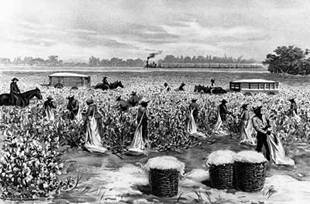
Duplin Roads Railroad Station:
According to Dr. James C. Burke’s research of the
Wilmington & Raleigh Railroad (later Wilmington & Weldon),
a map of 1833 “lists only six towns or named locations between Wilmington and Weldon that existed prior to the railroad that
would eventually become railroad towns – South Washington,
Wrightsville Post Office, Waynesborough (Goldsboro),
Rocky Mount, Enfield and Halifax. Not listed on the map,
but existing in 1833 was Duplin Cross Roads, the site
of a post office.”
Burke found also that by 1858 Duplin County stations listed with
their agents were Teachey’s (now Teachey), Magnolia (formerly Strickland’s Depot), Warsaw, Bowdens and Faison. He adds
that in 1858 Duplin Roads and Rose Hill had no station agent.

A photograph of the Halifax station house is the only known image
of early railroad structures, and probably dates from 1835. This
building may be atypical of those constructed along the line by
the Wilmington & Weldon’s completion by 1840, though they may
have been built after more practical storage warehouses. Any
station located at Duplin Roads by the mid-1850’s was probably
small and of very simple design and construction, and the lack
of facilities here is indicated in the early wartime report of
Wilmington & Weldon Superintendent Sewall L. Fremont
(see Notes below) to the President and Directors, found in
the November 25, 1861 Wilmington Journal:
“Thorough repairs should be made to the warehouses at
Joyner’s, Black Creek, Nahunta, Dudley, Faison and Warsaw.
At the latter station, the warehouse should be enlarged. Station houses, with ticket offices, should be constructed at Joyner’s,
Black Creek, Dudley, Faison and Warsaw; and small
warehouses, with ticket offices and passenger rooms should
be erected at Pikeville, Mount Olive, Duplin Cross Roads,
Leesburg and South Washington. I do not propose
large or costly structures, but plain, neat buildings.”
As a small station (albeit without an agent) may certainly have
existed at Duplin Roads, Fremont was advising his superiors that
a more commodious ticket office and passenger waiting rooms be
erected there to replace the aging and small original. One would
surmise too that storage sheds and warehouses may have existed near
the station to store agricultural products awaiting shipment.
Superintendent Fremont reported to the Directors in 1855 that
the bridge at Rockfish Creek south of Duplin Roads had been rebuilt,
one can still see the stone trestle foundations in the water today.
Duplin Men in Service During the War Between the States:
Duplin County supplied many men from Duplin Roads, Kenansville, Warsaw, Magnolia and Faison who fought in Virginia as well as
in the fortifications around Wilmington and Forts Fisher and Anderson
on the Cape Fear River. Among the first units formed as local militia
were the “Spartan Band” of Captain A.G. Mosely; the “Duplin Rifles” (organized at Kenansville in 1859) under Captain Thomas S. Kenan;
and the “Confederate Greys” under Captain Claudius B. Denson.
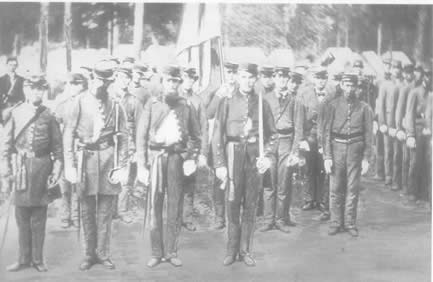
"The Duplin Grays"
The latter was largely composed of students at the Franklin
Military Institute near Faison, and it eventually became Company E
of the 20th North Carolina Regiment under Colonel (later General)
Alfred Iverson and Colonel Frank J. Faison of Duplin. The 20th and
fought at Malvern Hill, Seven Days, Mechanicsville, Cold Harbor,
South Mountain, Fredericksburg, Chancellorsville, Gettysburg,
the Wilderness, Spottsylvania, Petersburg and the Shenandoah
Valley.
In fierce battle at Gettysburg on the first day, the 20th
North Carolina Regiment lost every officer killed, wounded or
captured (of 24 being present), and only 16 men of the regiment led
by Lt. J.F. Ireland marched away from Gettysburg.
The names of the officers and soldiers of the Duplin units
include: Hicks, Sprunt, Oliver, Grimes, Blalock, Carr,
Kornegay, Wright, Barfield, Brinson, Brock, Branch, Davis,
Farrior, Faison, Futrall, Grady, Hall, Huggins, Kellit, Kenan,
Lanier, Outlaw, Padgett, Rogers, Strickland, Swinson,
Southerland, Tew, Wallace, Westbrook and Winders.
Additionally, many Duplin men served in the “Herring
Artillery” under Captain William A. Herring in Company I
of the 2nd North Carolina Artillery serving at Fort Johnson
in Smithville. Lieutenant Robert B. Carr of Duplin County
was wounded at Gettysburg and captured along with
Col. Thomas S. Kenan;
Carr became one of the “Immortal 600” Southern officers
used as human shields in front of Northern artillery batteries
at Charleston in 1864. Nearly starved by his captors, he
eventuallydied on July 3, 1865 of chronic intestinal disorders
brought on by the destructive prison diet.
Both of his brothers, Joseph and John, were killed in the war.

Col. Thomas S. Kenan
Duplin Roads During the War:
Though the seat of active warfare avoided Duplin Roads, its
agricultural products greatly helped the Southern war effort.
In 1865 the quartermaster general of North Carolina reported
that he was feeding half of Lee’s Army of Northern Virginia largely
with food brought through the blockade at Wilmington, and shipped
over the Wilmington and Weldon. Hence the Wilmington and
Weldon became known as the “lifeline of the Confederacy,”
and Duplin Roads was doing its part in providing agricultural
products to be shipped via rail, and cotton to be shipped to Europe
on blockade runners. During Wilmington’s devastating
yellow fever epidemic of late 1862, Duplin Roads and other
unaffected areas shipped great quantities of fresh vegetables
and fruit to the stricken city to help alleviate the suffering.
The Wilmington & Weldon was used extensively for troop
movements in eastern North Carolina throughout the war, and
relocating defenders to threatened areas. In December 1862
Lt. Col. John G. Pressley of the 25th South Carolina Volunteers
wrote of constant railroad movements of his regiment to Wilmington
and being quartered at "Camp Cobb, in wooden barracks near the
edge of the city, and near the Wilmington & Weldon railroad."
On December 18th he writes of "taking the cars" on
that afternoon in extremely cold weather and reaching
Magnolia station in Duplin County at 7AM the following day.
"The fact that we were the first regiment of soldiers the people
of this town had had with them and the proximity of the
enemy made us very welcome visitors. Many of the officers
and men were breakfasted by the citizens and treated
in the most hospitable manner."
After it was ascertained that the enemy had retired toward New Bern,
Lt. Col. Pressley's regiment reboarded the cars and reached
Wilmington on the 23rd of December where they were reviewed
by Major General William H.C. Whiting commanding
the Cape Fear District.

War again came near Duplin Roads in early July 1863 as an
enemy cavalry raid from New Bern got as close as Kenansville
and Warsaw, tearing up track and burning warehouses---
though this was quickly repaired by crews standing by for
such events. This brought more Southern troops to the
area to protect it from marauders.
The fear of sabotage and enemy raids was sufficient to have
24-hour guards posted at important railroad bridges in
Duplin County, including the stone-foundation trestle at
Rockfish Creek just south of present-day Wallace.
Prisoner Exchange Near Duplin Roads:
After the evacuation of Wilmington by General Robert F. Hoke
in late February, his brigades followed the Wilmington and Weldon
tracks to Rockfish Creek and encamped on the northern bank,
just below Duplin Roads. Hoke maintained a strong defensive line
here for nearly two weeks, and because a large number of
Northern prisoners were being held in North Carolinia, he began
treating with the enemy to take them off his hands as rations were
scarce and he had little for the captives.
General Braxton Bragg wrote to his superiors in Virginia from
“Rockfish Creek, Duplin County” on February 25, 1865 that
“Our main force is now located here, with the cavalry in advance
at Northeast (Cape Fear) River, where the enemy has finally,
under General Grant’s orders, consented to receive the
prisoners.”
Beginning on the 26th of February nearly 10,000 Northern prisoners
of war were to gather near Duplin roads, many brought by rail or
marched from Goldsboro. From General Hoke's lines on the north
bank of Rockfish Creek, the prisoners were sent down the railroad
to the north bank of the Northeast Cape Fear River for exchange.
They prisoners were ferried across the river to enemy lines at
Northeast Station, now Castle Hayne.
The diary of a soldier named Eldridge of the Third New
Hampshire Regiment records that “the rebel [rail] cars fetched
our prisoners (for parole) down from Goldsborough. They marched
by our camp.” He continued that “On the 26th…Received and
fed sixteen hundred prisoners. They are objects of pity.”
A previous battle fought on the very same ground as
Hoke had encamped was the “Battle of Rockfish,
on August 2, 1781.
Then, Colonel James Kenan of Duplin with 500 Duplin-area
militia confronted British Major James E. Craig’s large
force of Loyalists, with the former dispersed after firing
all their ammunition at the enemy.
Northern Troops Pass Through Duplin Roads:
As General Hoke’s forces departed his Rockfish Creek
encampment on March 5th for Kinston to confront an enemy
movment toward Goldsboro from New Bern, Northern troops
marched through Duplin County.
The railroad equipment not destroyed by retreating North Carolina
troops was put back into use between Northern-occupied
Wilmington and advancing Northern troops. As those forces
passed through Duplin Roads and Kenansville, farms were
raided and stripped of livestock and edibles, prompting one Duplin
lady to remark from her porch:
“What a set of vandals you Yankees are. You take all our sweet
potatoes and chickens, and, a day or two since some of
your tribe took our horses.”
An ironic twist of history is that 83 years earlier British General Cornwallis’s troops marched through Duplin County on their way
to Virginia and defeat. They encamped at the Old Duplin
Courthouse, which at that time was on Turkey Branch near
Warsaw. As the Northern invaders did in 1865, the British:
“burned and plundered as they stalked their way through the
county, leaving behind a path of destruction of farm pack
houses, crops, store buildings, and whatever else
was in their view”
(Chrysthine, Williams).
Sources:
North Carolina Gazetteer, William S. Powell, UNC Press, 1968
Our Living and Our Dead, 38th Regt NCT, Col. W.J. Hoke, Feb 1875
Flashes of Duplin’s History and Gov'tt, Faison & P. McGowen, 1971
History of the 117th NY Volunteers, J.A. Mowris, 1866
Chrysthine, Christine Williams, Pentland Press, 1999
Southern Historical Papers, Vol. XIV, J.W. Jones, pp. 44-45
The Wilmington & Raleigh Rail Road Company, J.C. Burke, 2009
Civil War Letters of W.D. Carr, Robert & Elsie J. Aycock, 1995
North Carolina History, Lefler & Newsome, UNC Press, 1954
The Papers of John W. Ellis, Nobel J. Tolbert, editor, NCDAH, 1964
Antebellum North Carolina, Social History, G. Johnson, UNC Press, 1937
The Papers of Zebulon B. Vance, Frontis Johnson, NCDAH, 1963
North Carolina Architecture, Catherine Bishir, UNC Press, 1990
Notes:
Sewall L. Fremont (1823-1886) was a native of Vermont and graduate of West Point, 1841, and rose to the rank of captain in the US Army before retiring in 1854; he then served as Chief Engineer and Superintendent of the Wilmington & Weldon Railroad from
1854-1871. Fremont also held the rank of Colonel, Chief of
Artillery and Engineers for the District of the Cape Fear,
North Carolina State Troops.
In 1871 he left the Wilmington &Weldon to take the same position with the Wilmington, Charlotte & Rutherford Railroad until retiring
in 1876. Fremont then was a rice planter near Wilmington for a
year or so, served as city surveyor 1880-1881, and a US government architect 1881-1886. He was the architect and superintendent of the North Carolina Asylum for the Colored Insane near Goldsboro.
In 1869 the North Carolina Legislature renamed the Wayne County town of Nahunta in honor of Colonel Fremont.
Stephen D. Wallace of Wilmington was elected president of the
Wilmington &Weldon upon the accidental death of William S. Ashe
in September 1862. Wallace had been for many years one of the officers of the road, having served as general ticket agent, assistant secretary, bookkeeper and accountant. He was also chairman of the Wilmington school board and in 1864 served as chairman of the Wilmington relief association. After the war he was a commission merchant in Wilmington.
©2006 Cape Fear Historical Institute